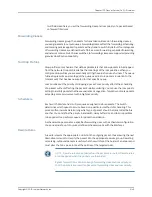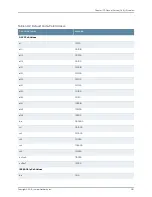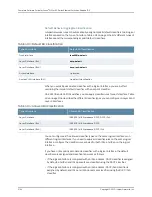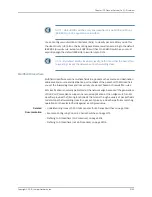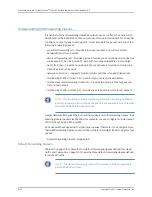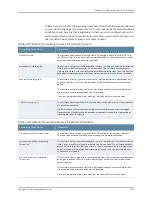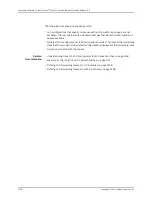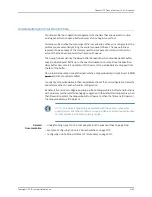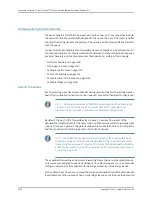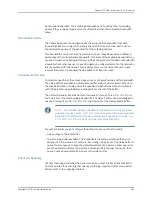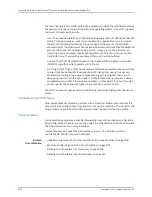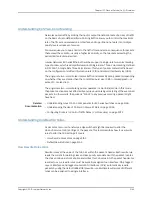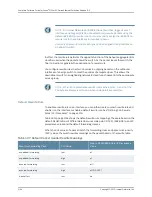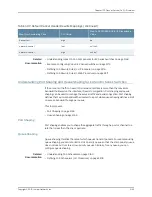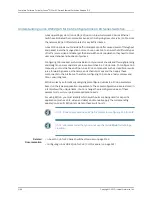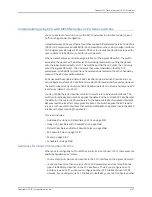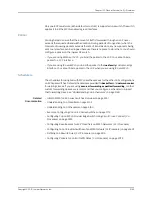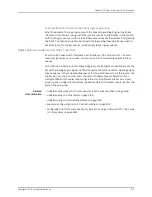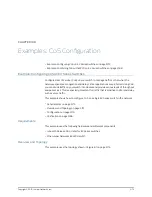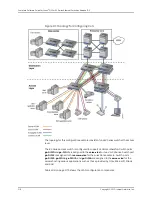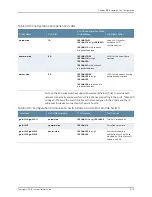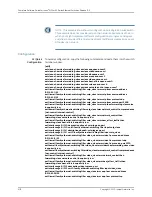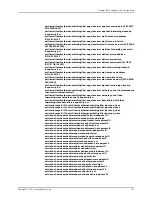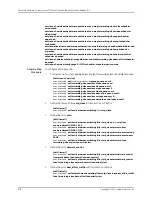
Understanding CoS Two-Color Marking
Networks police traffic by limiting the input or output transmission rate of a class of traffic
on the basis of user-defined criteria. Policing traffic allows you to control the maximum
rate of traffic sent or received on an interface and to partition a network into multiple
priority levels or classes of service.
Policers require you to apply limits to the traffic flow and set a consequence for packets
that exceed these limits—usually a higher loss priority, so that packets exceeding the
policer limits are discarded first.
Juniper Networks EX Series Ethernet Switches support a single-rate two-color marking
type of policer, which is a simplified version of Single-Rate-Three-Color marking, defined
in RFC 2697,
A Single Rate Three Color Marker
. This type of policer meters traffic based
on the configured committed information rate (CIR) and committed burst size (CBS).
The single-rate two-color marker meters traffic and marks incoming packets depending
on whether they are smaller than the committed burst size (CBS)—marked green—or
exceed it— marked red.
The single-rate two-color marking policer operates in color-blind mode. In this mode,
the policer's actions are not affected by any previous marking or metering of the examined
packets. In other words, the policer is “blind? to any previous coloring a packet might
have had.
Related
Documentation
Understanding Junos OS CoS Components for EX Series Switches on page 3148
•
•
Understanding the Use of Policers in Firewall Filters on page 3036
•
Configuring Policers to Control Traffic Rates (CLI Procedure) on page 3073
Understanding CoS Rewrite Rules
As packets enter or exit a network, edge switches might be required to alter the
class-of-service (CoS) settings of the packets. This topic describes how to use rewrite
rules to alter the CoS settings. It covers:
•
How Rewrite Rules Work on page 3163
•
Default Rewrite Rule on page 3164
How Rewrite Rules Work
Rewrite rules set the value of the CoS bits within the packet’s header. Each rewrite rule
reads the current forwarding class and loss priority associated with the packet, locates
the chosen CoS value from a table, and writes this CoS value into the packet header. For
rewrites to occur, rewrite rules must be explicitly assigned to an interface. Only tagged
Layer 3 interfaces and tagged routed VLAN interfaces (RVIs) automatically rewrite
packets by using the default IEEE 802.1p rewrite rule. Multiple rewrite rules of different
types can be assigned to a single interface.
3163
Copyright © 2010, Juniper Networks, Inc.
Chapter 107: Class of Service (CoS)—Overview
Summary of Contents for JUNOS OS 10.3 - SOFTWARE
Page 325: ...CHAPTER 17 Operational Mode Commands for System Setup 229 Copyright 2010 Juniper Networks Inc ...
Page 1323: ...CHAPTER 56 Operational Mode Commands for Interfaces 1227 Copyright 2010 Juniper Networks Inc ...
Page 2841: ...CHAPTER 86 Operational Commands for 802 1X 2745 Copyright 2010 Juniper Networks Inc ...
Page 3367: ...CHAPTER 113 Operational Mode Commands for CoS 3271 Copyright 2010 Juniper Networks Inc ...
Page 3435: ...CHAPTER 120 Operational Mode Commands for PoE 3339 Copyright 2010 Juniper Networks Inc ...
Page 3529: ...CHAPTER 126 Operational Mode Commands for MPLS 3433 Copyright 2010 Juniper Networks Inc ...

